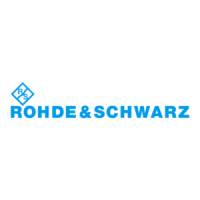Concepts and features
R&S
®
ZNA
173User Manual 1178.6462.02 ─ 20
4.5.2.1 Calibration standard types
The following table gives an overview of the different standards and their circuit models
(offset and load models).
Table 4-8: Calibration standard types
Standard Type Characteristics Ideal Standard Offset Model Load Model
Open Open circuit (one-port) ∞ Ω
☑ ☑
Short Short circuit (one-port) 0 Ω
☑ ☑
Offset short Short circuit with added electrical length offset, for
waveguide calibration (one-port)
0 Ω
☑ ☑
Match Matched broadband termination (one-port) Z
0
(characteristic
impedance of the
connector type)
☑ ☑
Sliding match One-port standard consisting of an air line with a
movable, low-reflection load element (sliding load)
– – –
Reflect Unknown mismatched standard (one-port) ∞ Ω
☑ ☑
Through Through-connection with minimum loss (two-port) –
☑
–
Line1, Line 2 Line(s) for TRL calibration with minimum loss (two-
port)
–
☑
–
Attenuation Fully matched standard in both directions (two-
port; the reflection factor at both ports is zero)
– – –
Symm. network Unknown mismatched reflection-symmetric stan-
dard (two-port)
–
☑ ☑
Offset parameters
The offset parameters have the following physical meaning:
●
The delay is the propagation time of a wave traveling through the standard. The
electrical length is equal to the delay times the speed of light in the vacuum. It is a
measure for the length of transmission line between the standard and the actual
calibration plane. For a waveguide with permittivity ε
r
and mechanical length L
mech
,
the following relations hold:
rmech
rmech
L
c
L
Length Electrical;Delay
The default delay is 0 s, the default step width is 1 ns, corresponding to a step
width of 299.792 mm for the electrical length. The relations hold for one-port and 2-
port standards.
●
Z
0
is the characteristic impedance of the standard. If the standard is terminated
with Z
0
, then its input impedance is also equal to Z
0
. Z
0
is not necessarily equal to
the reference impedance of the system (depending on the connector type) or the
terminal impedance of the standard. The characteristic impedance of the standard
is only used in the context of calibration.
The default characteristic impedance is equal to the reference impedance of the
system.
Calibration

